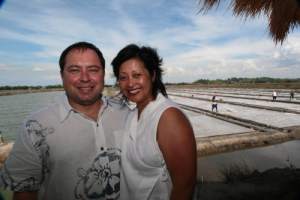Old Sea Salts Thrive in New Markets
 With less than one percent of the worlds total salt production, the country has a limited resource. Combined with globalization of a free market system, the age old war of small farmer versus large producer has had a profound effect on the industry and its caretakers. In less than 15 years, the Philippine sea salt industry has seen a decline caused by cheaper imports from neighboring countries as well as competition against companies with big dollars. The effect, fewer than fifty percent of producers remain holding the knowledge of traditional methods of production.
With less than one percent of the worlds total salt production, the country has a limited resource. Combined with globalization of a free market system, the age old war of small farmer versus large producer has had a profound effect on the industry and its caretakers. In less than 15 years, the Philippine sea salt industry has seen a decline caused by cheaper imports from neighboring countries as well as competition against companies with big dollars. The effect, fewer than fifty percent of producers remain holding the knowledge of traditional methods of production.
Surrounded by pristine waters, the Pangasinan region of the Philippines is known for its indigenous sea salt-making industry. The name itself translates to land of salt or place where salt is made. Geographically, the region refers to the province at the northern end of Central Luzon and is favored for its mineral rich and fine salt beds. Salt season lasts only until the rains fall. In 2008, the rains came early, cutting short two months of production, thus further creating scarcity. But in a land of scarcity comes biodiversity. Sea salt pans are flooded and farming changes to fish and shrimp crops; a sustainable and eco-friendly use of the land.
When good taste is paired with social responsibility, the results are gratifying. While visiting family in the Philippines in 2004, Lennie and Anthony DiCarlo sampled and instantly admired the local markets culinary sea salts. Utilizing their culinary and business backgrounds, they launched the company in an effort to preserve and exalt the traditional, eco-friendly production of sea salts. Chefs and restaurants that place orders through xroads and their distributors will help a community almost a world away while diversifying their own arsenal of specialty food pantry stock.
Lennie DiCarlo, a graduate of the CCA in San Francisco and CEO of xroads said, The structure of our sea salts contain both the granular and flake (fleur de sel) crystals. This composition provides texture from the hollow crystals while the flakiness melts immediately on the palate to yield instantaneous taste.
 As a result of extreme temperatures during salt season ranging in 100+ Fahrenheit degrees, crystals form instantaneously, creating hollow saline structures, a textural element that chefs appreciate. Furthermore, because of the temperature, the fleur de sel flake is not separated but harvested as it forms. A combination of the granular and flake crystals creates a unique mouth feel that top chefs in North America are taking notice.
As a result of extreme temperatures during salt season ranging in 100+ Fahrenheit degrees, crystals form instantaneously, creating hollow saline structures, a textural element that chefs appreciate. Furthermore, because of the temperature, the fleur de sel flake is not separated but harvested as it forms. A combination of the granular and flake crystals creates a unique mouth feel that top chefs in North America are taking notice.